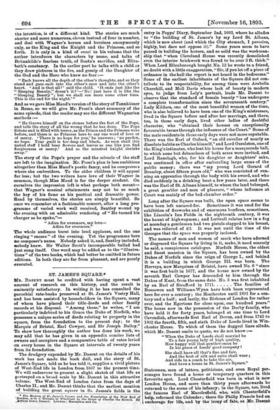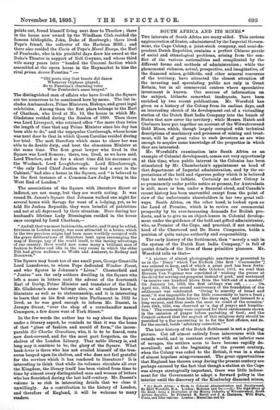ST. JAMES'S SQUARE.*
Mn. DASENT must be credited with having spent a vast amount of research on this history, and the result is eminently satisfactory. In writing it he has consulted the parochial rate-books preserved at St. James's Vestry Hall, and has been assisted by householders in the Square, many of whom have placed their title-deeds and other family records at his disposal. "Among these," he writes, "I am particularly indebted to his Grace the Duke of Norfolk, who possesses a unique series of deeds relating to property in the square, from the foundation to the present day ; to the Marquis of Bristol, Earl Cowper, and Sir Joseph Bailey." To show how thoroughly the author has done his work, we may add that he has given in an appendix concise lists of owners and occupiers and a comparative table of rates levied on every house in the Square at intervals of twenty years from its foundation.
The drudgery expended by Mr. Dasent on the details of his work has not made the book dull, and the story of St. James's Square, told as he has told it, supplies a vivid picture of West-End life in London from 1667 to the present time. We will endeavour to present a slight sketch of that life as portrayed on a broad scale by Mr. Dasent in this attractive volume. The West-End of London dates from the days of Charles IL, and Mr. Dasent thinks that the earliest mention -of building the great square in St. James's fields is the
• don, The Ilitshtory. af,,,,S:1,....TWIlee$ Square and the Foundation of the West End of Arthur Irwin Dasent.. "LoofudonVacit tphe Rdes a of Charges the Second. By I help, reformed the Calendar; there Sir Philip Francis had an entry in Pepys' Diary, September 2nd, 1663, where he alludes to "the building of St. James's by my Lord St. Albans, which is now about (and which the City stomach, I perceive, highly, but dare not oppose it)." Some years seem to have passed in building the houses, and so solid was the workman- ship that "when Cleveland House was recently demolished even the interior brickwork was found to be over 3 ft. thick." When Lord Ellenborough bought No. 13 he wrote to a friend, no doubt with a little exaggeration, "Sir, if you let off a piece of ordnance in the hall the report is not beard in the bedrooms." Some of the earliest inhabitants of the Square did not con- tribute to its respectability, for among them were Arabella Churchill, and Moll Davis whose lack of beauty in modern eyes, to judge from Lely's portrait, leads Mr. Dasent to observe that the standard of female beauty "has undergone a complete transformation since the seventeenth century." Lady Kildare, one of the most beautiful women of the time, who is also believed to have been one of the King's mistresses, lived in the Square before and after her marriage, and there, too, in those early days, lived other ladies of doubtful character, who "obtained their houses on exceptionally favourable terms through the influence of the Court." Some of the male residents in those early days were not more reputable. There was the Earl of Oxford, "an old cavalier of nearly as dissolute habits as Charles himself," and Lord Ossulston, one of the King's intimates, who lent his house for a masquerade ball, to which none but debauchees of both sexes were invited, and Lord Ranelagh, who, for his daughter or daughters' sake, was continued in office after embezzling large sums of the public money ; there was "my young Lord Gerard of Bromley, about fifteen years old," who was convicted of run- ning an apprentice through the body with his sword, and who died suddenly in a drinking bout a few years later, and there was the Earl of St. Albans himself, to whom the land belonged, a great gambler and man of pleasure, "whose influence at Court was mainly of the bed-chamber order."
Long after the Square was built, the open space seems to have been left uncared-for. Sometimes it was used for the exhibition of fireworks and of enormous bonfires, sometimes, like Lincoln's Inn Fields in the eighteenth century, it was the haunt of highwaymen; and Luttrell relates how in a fog at noonday a gentleman had two pistols clapped to his breast, and was relieved of £3. It was not until the time of the Georges that the space was properly inclosed.
The names of men and women of mark who have adorned or disgraced the Square by living in it, make, it need scarcely be said, a conspicuous catalogue. Norfolk House, the oldest and finest mansion in the Square, has been owned by the Dukes of Norfolk since the reign of George I., and behind it is a building in which George III. was born. The Herveys, now Marquises of Bristol, have owned No. 6 "since it was first built in 1677, and the house now owned by the seventh Earl Cowper has descended to him through the Dukes of Kent, from the same date. No. 5 was first inhabited
by an Earl of Strafford in 1711 The families of Boscawen and Williams-Wynn have both been represented here for over a century ; the Heathcotes until 1891 for a cen- tury and a half ; and lastly, the Bishops of London for rather over, and the Egertons for close upon, one hundred years." The house now in the possession of the Derby family, who have held it for forty years, belonged at one time to Lord Cavendish, afterwards first Earl of Devon, and from 1742 to 1802 the fourth, fifth, and sixth Duke of Leeds lived in Win- chester House. To which of them the doggrel lines allude, which Mr. Dasent omits to quote, we do not know :- "When the Duke of Leeds shall married be To a fair young lady of high quality, How happy will that gentlewoman be In his grace of Leeds' good company !
She shall have all that's fine and fair,
And the best of silk and satin shall wear ; And ride in a coach to take the air, And have a house in St. James's Square."
Statesmen, men of letters, politicians, and even Royal per. sonages have found a home or temporary quarters in this favourite spot. Lord Chesterfield was born in what is now London House, and more than thirty years afterwards he returned to the scene of his infancy ; in the Square, too, lived the famous Earl of Macclesfield, who, with Chesterfield's
Arthur Irwin Dasent.. "LoofudonVacit tphe Rdes a of Charges the Second. By I help, reformed the Calendar; there Sir Philip Francis had an
anchorage for life, and by the irony of fate, as Mr. Dasent points out, found himself living next door to Thurlow ; there in the house now owned by the Windham Club resided the famous bibliophile, John, Duke of Roxburgh; there lived Pope's friend, the collector of the Harleian MSS.; and there also resided the Curio of Pope's Moral Essays, the Earl of Pembroke, who in his youthful days drew his sword at the Duke's Theatre in support of Nell G-wynne, and whose third wife many years later "headed the Cuzzoni faction which assembled at the opera house in the Haymarket to hiss the rival prima donna Faustina "
"Old poets sing that beasts did dance
Whenever Orpheus played ; So to Faustina,'s charming voice Wise Pembroke's asses brayed."
The distinguished men of affairs who have lived in the Square are too numerous to be mentioned here by name. The list in- cludes Ambassadors, Prime Ministers, Bishops, and great legal celebrities. Among them the first place belongs to the Earl of Chatham, who lived at No. 10, the house in which Mr. Gladstone resided during the Session of 1890. Then there was Lord Liverpool, who retained office "for more than twice the length of time that any Prime Minister since his day has been able to do," and the unpopular Castlereagh, whose house
was next door to that in which Queen Caroline resided during her trial. The mob therefore which came to cheer her was able to do double duty, and boot the obnoxious Minister at the same time. The first great lawyer who lived in the
Square was Lord Somers ; there, too, lived, as we have said, Lord Thurlow, and so for a short time did his successor on the Woolsack, Lord Loughborough. Lord Ellenborough, "the only Lord Chief Justice who ever had a seat in the Cabinet," had also a house in the Square, and "is believed to be the first instance of a Common-Law Judge living in the West End of London."
The associations of the Square with literature direct or indirect, are not many, but they are worth noting. It was round St. James's Square that Johnson walked one night for several hours with Savage for want of a lodging, yet, as he told Sir Joshua Reynolds, they were brimful of patriotism and not at all depressed by their situation. Here during her husband's lifetime Lady Blessington resided in the house once occupied by Lord Chatham,—
" And all that was most fashionable, artistic, and it may be added, frivolous in London society, was soon attracted to a house, which in the two previous reigns had been more worthily occupied with the grave deliberations of Ministers bent upon rearranging the map of Europe, nay 3f the world itself, to the lasting advantage of our country. Here would now come many a brilliant man of fashion to flatter and idle in the very rooms in which the elder Pitt had given audience to Wolfe and Amherst, to Rodney and Boscawen,"
The Square may boast too of one small poet, George Granville Lord Lansdowne, to whom Pope dedicated Windsor Forest, and who figures in Johnson's "Lives." Chesterfield and " Junius " are the only authors dwelling in the Square who left a name in letters until the advent of the fourteenth Earl of Derby, Prime Minister and translator of the Iliad.
Mr. Gladstone's name belongs also, as all readers know, to literature as well as to statesmanship, and it is interesting to learn that on his first entry into Parliament in 1832 he lived, as he was good enough to inform Mr. Dasent, in Jermyn Street, "over the shop of a cornehandler named Crampern, a few doors west of York Street."
In the few words the author has to say about the Square under a literary aspect, he reminds us that it was the home of that "glass of fashion and mould of form," the incom- parable Sir Charles Grandison, who, it is to be feared, rests now duet-covered, and for the most part forgotten, on the shelves of the London Library. That noble library is, and long may it continue to be, the glory of the Square. What book-lover is there who has not availed himself of the trea- sures heaped upon its shelves, and who does not feel grateful for the services which it has rendered to literature ? It is interesting to think that while its volumes circulate all over the Kingdom, the library itself has been visited from time to time by almost every distinguished man and woman of letters who has flourished during the last half-century. Mr. Dasent's volume is so rich in interesting details that we close it unwillingly. As a contribution to the history of London, and therefore of England, it will be welcome to many readers.



















































 Previous page
Previous page